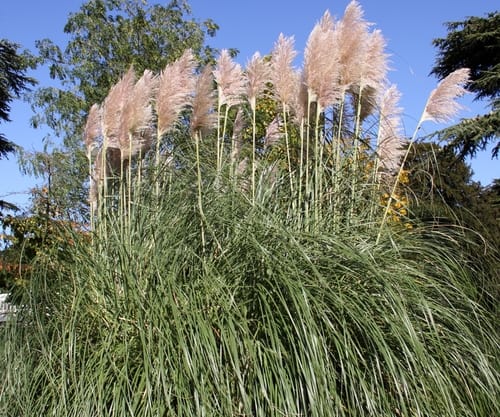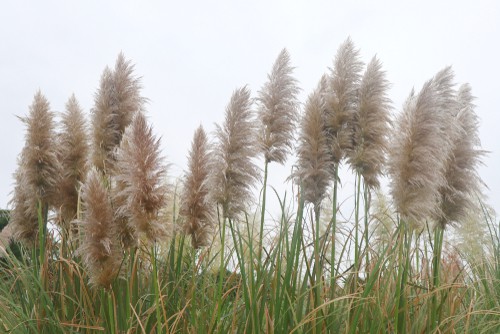Last updated on March 21st, 2022
Our site is reader supported, this means we may earn a small commission from Amazon and other affiliates when you buy through links on our site.
We have talked about a lot of grasses on this website and what springs to mind when you think about ornamental grasses? Well, most who think of ornamental grasses, think of the tall, feathery tipped grasses swaying in the wind. They think of pampas grass.
Pampas grasses produce the creamy, white plumes that take on the appearance of feathers atop larger clumps of foliage. There are some varieties with pink plumes available too, such as Cortaderia selloana ‘Rosea’. Regardless of colour, this ornamental grass is a popular addition to any landscape, not just because of its appearance, but because of its simple maintenance.
The most common varieties, such as the pampas grass ‘Patagonia’, generally grow to approximately 8ft tall, but what most people don’t realise is that you can purchase dwarf varieties that only grow to around 1-1.5 metres tall, one example is the pampas grass ‘Pumila’. We recently talked about this variety in an article on the best evergreen grasses for containers here.
How to Grow Pampas Grasses
The first thing you need to know is the eventual size it will reach. As previously mentioned, pampas grasses can reach 1-3 metres wide and tall, so you should only plant them somewhere there is enough room to grow the variety you choose, better yet choose a variety to suit the location you have available. If you are planting more than one, you want to give them at least 1-2 metres of space between each plant. Don’t forget that you will need to get right around the plant to prune them and keep them tidy.
Pampas grasses prefer full sunlight but can be grown in partial shade, however, we would always recommend planting them in full sun if possible to get the best out of it. It likes moist, well-drained soil and is otherwise tolerant of all soil types which is a good thing. You will find it commonly grown along the coast because of its tolerance to salt sprays, wind and drought.

You can also grow them in containers, but again, given the size of most varieties, it might be a bit impractical and they are better suited for large raised flowerbeds or directly in the ground. Don’t forget if you only have limited space and have no option but to plant one in a pot, choose a good-sized pot and use a variety such as pampas grass ‘Pumila’ that is classed as a dwarf in pampas grass terms, although they will still reach 5ft.
Pampas Grass Care
Once your pampas grass is planted, it requires very little care other than needing water for the first few months until established, and in the event that your area experiences periods of drought. Annually it requires some pruning, which is something to do carefully. You can, with clumps far from a structure, burn foliage down in order to allow for greener growth too. You do not have to, but you can apply balanced fertilisers if you want to encourage newer growth but this is something we often don’t do ourselves as they are very robust and bounce back.
Pruning Pampas Grasses

If you are considering pruning your pampas grass, it should be done in winter, ideally, January or February or early spring before the new shoots start shooting when the weather starts to warm a little. You don’t want to do it in the summer because you can damage the plant and promote new flowering spikes that will later produce stunning flowers, which is obviously something you want to avoid.
Remember that the blades on the leaves are extremely sharp and will cut you if you are not properly geared. When you go to prune your pampas grass, make sure you are wearing long sleeves, pants and good quality gloves. The pampas grasses are very strong so regular hand clippers will not suffice in some cases. This job is best done with the use of a hedge trimmer or loppers.
You can read our detailed guide on pruning pampas grasses here.
Propagating Pampas Grasses by Dividing Plants

You can propagate your pampas grass by dividing the existing plants, much the same as you would divide any other perennial. You might need a friend to lend a hand both literally and figuratively for this process because the root clumps can be quite heavy and pampas grasses are fairly large plants.
For this process, you need to dig up the crown, being careful not to harm the root system underneath. If needed you can rinse any soil away from the root structure so that you can have an unobstructed view. Once the soil and debris have been removed you can use two shovels or gardening forks back-to-back and place them directly down into the clump where you are going to make your separation. Pull them apart to separate the clumps of pampas grass. Replant both of your divisions and water them well.
Pest and Diseases
Pampas grass is one of the more popular ornamental grasses, regardless of recommended varieties you plant, because they are generally resistant to pests and diseases.


